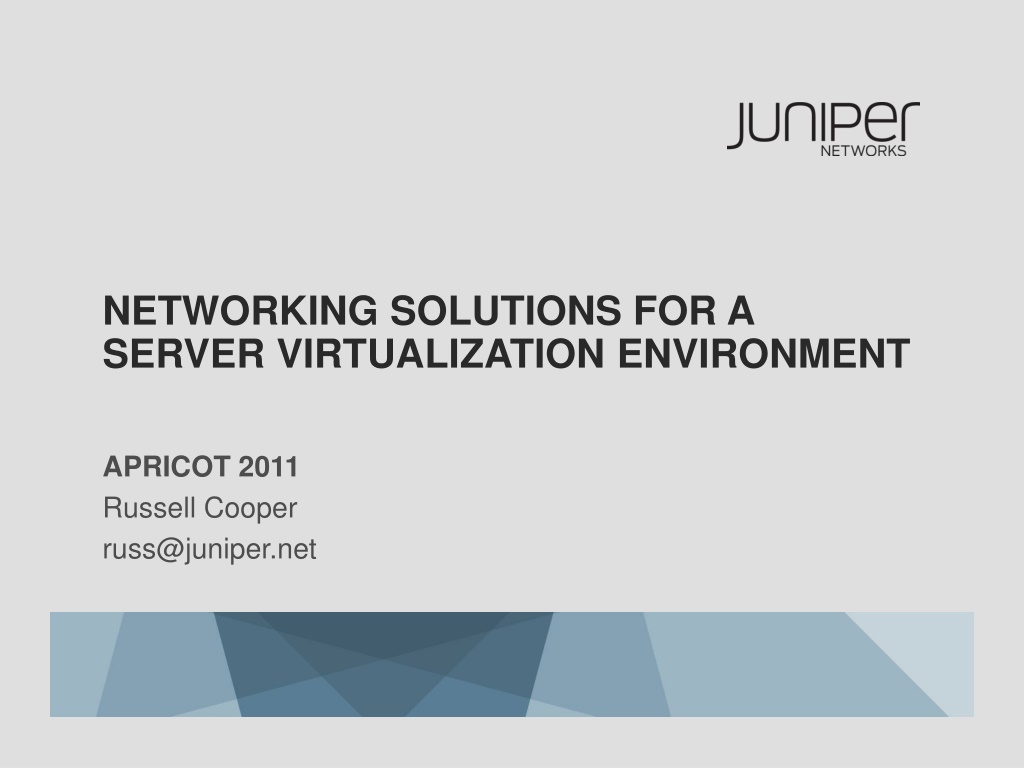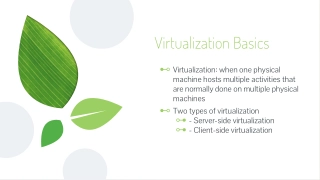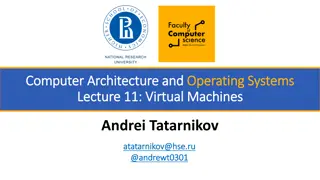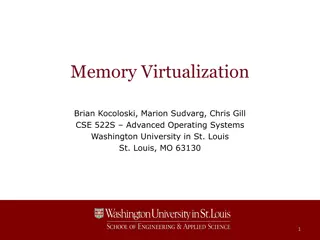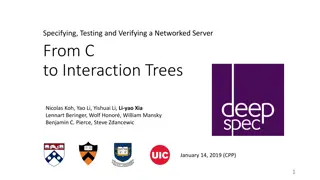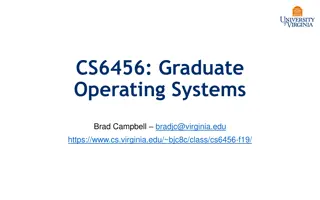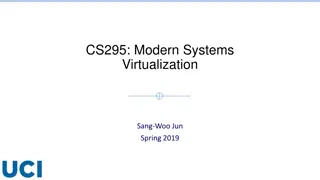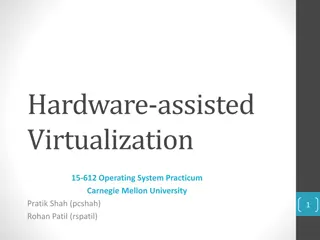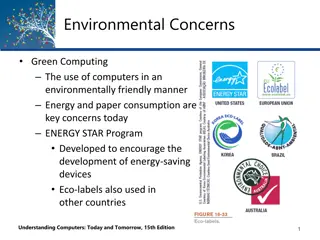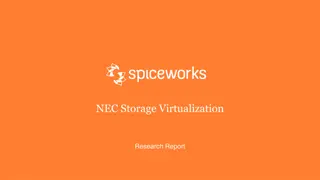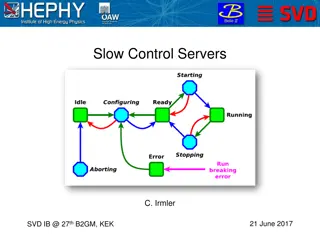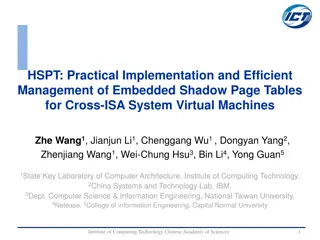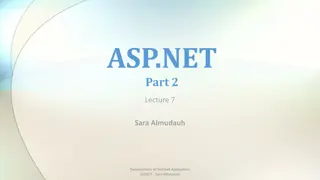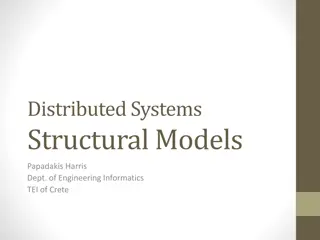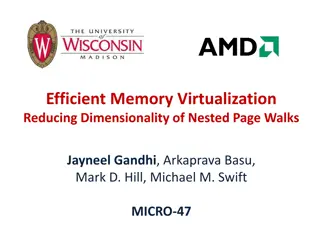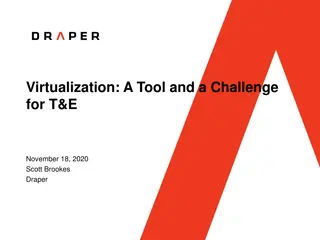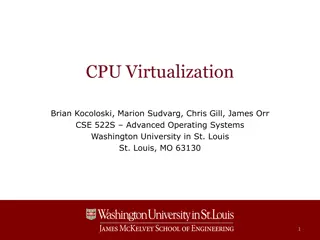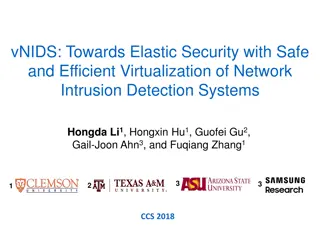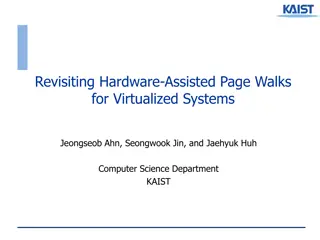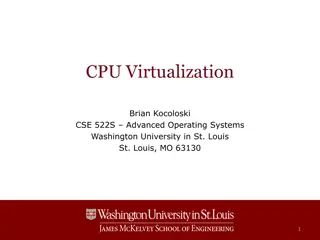Networking Solutions for Server Virtualization Challenges
This presentation discusses the challenges server virtualization technologies bring to data center networks. It demonstrates a standards-based approach to enhance the experience and economics in a virtualized environment. Topics include market drivers, limitations of legacy networks, simplification solutions, and the evolution of server virtualization. Legacy networks restrict agility but can be simplified to support server virtualization effectively.
- Networking Solutions
- Server Virtualization
- Data Center Networks
- Standards-Based Approach
- Legacy Networks
Download Presentation

Please find below an Image/Link to download the presentation.
The content on the website is provided AS IS for your information and personal use only. It may not be sold, licensed, or shared on other websites without obtaining consent from the author. Download presentation by click this link. If you encounter any issues during the download, it is possible that the publisher has removed the file from their server.
E N D
Presentation Transcript
NETWORKING SOLUTIONS FOR A SERVER VIRTUALIZATION ENVIRONMENT APRICOT 2011 Russell Cooper russ@juniper.net
WHAT YOU WILL GET FROM THIS SESSION 1. Talk: about challenges Server Virtualization technologies brings for the data center networks. 2. Demonstrate: standards based approach, where available, to improve the experience and economics in a virtualized environment. 2
AGENDA 1. Market Drivers 2. Limitations of legacy network 3. Solutions Simplification Infrastructure Enhanced services 4. Summary 3
THE EVOLUTION OF SERVER VIRTUALIZATION PHASE 1 PAST PHASE 2 FUTURE Server Consolidation Business Agility Guiding Principle: Improve utilization of physical resources Guiding Principle: : Improve utilization of a pool of resources Driver: Power and space Improvements in server utilization Savings Driver: Adapt quickly to new demands Heightened compliance & security Better disaster management Cloud Based Computing Models Network had no role Network has a huge role 4
LEGACY NETWORKS RESTRICT AGILITY Too Many Devices to Manage Additional virtual switches COMPLEX: LACK OF ADDITIONAL SERVICES: INFRASTRUCTURE: POOR PERFORMANCE Multiple layers Across North-South path MOBILITY: North-south path Scale & scope of L2 adjacencies Across sites PROPRIETARY: Pre-standard protocols SECURITY: Silo ed , unavailable across domains Intra- VM traffic NIC NIC MANAGEABILITY: Orchestration between the physical and virtual network VM1 VM2VM3 VM1 VM2 VM3 5 SERVER 1 SERVER 2
NETWORK SIMPLIFICATION FOR SUPPORTING SERVER VIRTUALIZATION Too Many Devices to Manage SIMPLIFICATION Additional virtual switches COMPLEX: LACK OF ADDITIONAL SERVICES: NEEDED ENHANCED SERVICES INFRASTRUCTURE: INFRASTRUCTURE THAT IS: POOR PERFORMANCE Multiple layers Across North-South path MOBILITY: North-south path Scale & scope of L2 adjacencies Across sites HIGH PERFORMANCE MOBILITY PROPRIETARY: Pre-standard protocols Interoperability Lock-in SECURITY: Silo ed , unavailable across domains Intra- VM traffic OPEN, STANDARDS BASED SECURITY NIC NIC MANAGEABILITY: Orchestration between the physical and virtual network MANAGEABILITY VM1 VM2VM3 VM1 VM2 VM3 6 SERVER 1 SERVER 2
NETWORK DEVICE CLUSTERING SIMPLIFICATION Fewer devices to manage: 44 -> 4 BEFORE AFTER 7
TECHNOLOGY APPROACHES Control Plane Unification L2 Table Synch Facts Facts Simplify operations Behaves as a single node both at L2 & L3 layers so it inherits all benefits found in L2 Table Synch approach Distributed link aggregation (LAG) plus some L2/L3 protocols enhancements to minimize interchassis link load Multiple Devices Enhanced Protocols Multiple Devices One Control Plane 8
OPEN STANDARDS BASED SIMPLIFICATION ENHANCED SERVICES NEEDED INFRASTRUCTURE THAT IS: HIGH PERFORMANCE MOBILITY OPEN, STANDARDS BASED SECURITY MANAGEABILITY 9
COMMUNICATION BETWEEN THE VIRTUAL MACHINES NIC NIC NIC VM1 VM2 VM3 VM1 VM2 VM3 VM1 VM2 VM3 2. In the NIC 3. In the existing external physical switch (VEPA) 1. In the hypervisor vendor s switch(e.g. VM Ware vSwitch) 10
COMPARING VEPA AND VEB Network services in hardware Physical switch NIC NIC Hypervisor/software Network services in software switch VM1 VM2 VM3 VM1 VM2 VM3 Virtual Ethernet Port Aggregator (VEPA) North South optimized Full functioned hardware switch Virtual Ethernet Bridge (VEB) East West optimized Limited function software switch 11
COMPARISON OF OPTIONS 1 2 3 vSwitch NIC VEPA Switching done in Software Hardware Hardware Feature Richness Very Low Low High Low comes in- built with hypervisor Low - simple software upgrade Customer s Time to adopt solution Unknown Customers Cost to adopt Low comes with hypervisor Free - software upgrade Unknown Compatibility with any existing network Yes Unknown Yes Very Low Latency for switching Very Low Low Industry support (standards based) NA Unknown Yes Virtual switching managed by Network Admin Server admin Unknown 12
VEPA Virtual Ethernet Port Aggregator Uses external physical network for intra- server VM to VM communication It s an evolving open standard IEEE 802.1Qbg / 802.1Qbh Supported by almost all the major IT vendors For more information http://www.ieee802.org/1/files/public/docs2 009/new-bg-thaler-par-1109.pdf http://www.ieee802.org/1/pages/802.1bg.ht ml NIC VM1 VM2 VM3 VEPA brings the evolved Ethernet functionality to virtual networking 13
TOP 3 BENEFITS OF VEPA Elegant Features & Scale Open VEPA is a non-disruptive and cost-effective Switching where it belongs on the switches Server and hypervisor agnostic, maximum flexibility. 14
HIGH PERFORMANCE SIMPLIFICATION ENHANCED SERVICES NEEDED INFRASTRUCTURE THAT IS: HIGH MOBILITY PERFORMANCE OPEN, STANDARDS BASED SECURITY MANAGEABILITY 15
LATENCY WITH LEGACY NETWORK Every hop adds additional latency Increases load on uplinks Requires VLANs to span multiple access switches to support VM migration A B 16
VIRTUALIZATION WITH CHASSIS CLUSTERING 10x latency improvement by eliminating trip to upper layers Single-point lookup model Works with any Hypervisor Clustered Access Switches A B 17
MOBILITY SIMPLIFICATION ENHANCED SERVICES NEEDED INFRASTRUCTURE THAT IS: HIGH MOBILITY PERFORMANCE OPEN, STANDARDS BASED SECURITY MANAGEABILITY 18
NETWORK REQUIREMENTS FOR VM MOBILITY IP network with 622 Mbps is required. The maximum latency between the two servers < 5 milliseconds (ms). Access to the IP subnet & data storage location Access from vCenter Server and vSphere Client. Same IP subnet & broadcast domain Layer 2 adjacency VLAN stretch 19
VM MIGRATION SCENARIOS Scenario #1 Scenario #2 Scenario #3 Within Same Data Center Data Centers in the same City - two different locations Data Centers in different Cities VPLS Clustered Access Switches Clustered Access Switches Clustered Access Switches Data Center Data Center Data Center Data Center Remember the vMotion Requirements! Bandwidth/Latency/IP Subnet/VLAN Rack A Layer 2 domain across racks Rack A Layer 2 domain across virtual private LAN Layer 2 domain across fiber connected data centers 20
RACK TO RACK RACK 1 RACK 2 Top-of-Rack / End-of- Row Clustered Switches NIC NIC Managed as a single device Automatic VLAN update propagation. Sub 10us latency VM1 VM2 VM3 VM4 VM5 21
POD TO POD Core Clustered Chassis Extends L2 domain across multiple Rows/Pods in a DC Clustered Access Switches Extends L2 adjacency to over 10,000 1GbE servers NIC NIC NIC NIC NIC NIC Eliminates STP Core managed as a single device VM1 VM2 VM3 VM4 VM5 VM1 VM2 VM3 VM4 VM5 VM1 VM2 VM3 VM4 VM5 POD 1 POD N 22
ACROSS DC/CLOUDS Routers With VPLS VPLS Over MPLS Cloud Routers with VPLS Extends L2 domain across DC /clouds Core Switches Core Switches Allows VM Motion across locations. VPLS can be provisioned or orchestrated using vendor tools and scripts NIC NIC NIC NIC NIC NIC NIC NIC Access Switches Access Switches NIC NIC NIC NIC VLAN to VPLS mapping DB/Storage mirroring VM1 VM1 VM2 VM2 VM1 VM3 VM3 VM2 VM4 VM4 VM5 VM5 VM4 VM1 VM1 VM2 VM2 VM1 VM3 VM3 VM2 VM4 VM4 VM5 VM5 VM4 VM3 VM5 VM6 VM3 VM5 23
MANAGEABILITY SIMPLIFICATION ENHANCED SERVICES NEEDED INFRASTRUCTURE THAT IS: HIGH MOBILITY PERFORMANCE OPEN, STANDARDS BASED SECURITY MANAGEABILITY 24
DC MANAGEABILITY CHALLENGES WITH SERVER VIRTUALIZATION B Physical n/w 1. Blurred roles between the server and network admin. Network Admin 2. No automation/ orchestration to sync-up the 2 networks. A A P P Virtual n/w VM1 VM2 VM3 VM1 VM2 3. VM Migration can fail. Server Admin 4. Proprietary products & protocols 25
ONE STEP ORCHESTRATION A Network Admin Physical n/w A A 1. Clear roles and responsibilities Orchestration Tools A 2. Automated orchestration between physical and virtual networks A A P P Virtual n/w 3. Scalable solution allows VMs to move freely VM1 VM2 VM3 VM1 VM2 Server Admin 4. Open Architecture 26
SECURITY SIMPLIFICATION ENHANCED SERVICES NEEDED INFRASTRUCTURE THAT IS: HIGH MOBILITY PERFORMANCE OPEN, STANDARDS BASED SECURITY MANAGEABILITY 27
SECURITY IMPLICATIONS OF VIRTUAL SERVERS PHYSICAL NETWORK VIRTUAL NETWORK VM1 VM2 VM3 ESX Host HYPERVISOR Firewall/IPS Inspects All Traffic Between Servers Physical Security is Blind to Traffic Between Virtual Machines 28
APPROACHES TO SECURING VIRTUAL SERVERS: THREE METHODS 1. VLAN Segmentation 2. Agent-based 3. Kernel-based Firewall Each VM in separate VLAN Each VM has a software firewall VMs can securely share VLANs Inter-VM communications must route through the firewall Drawback: Significant performance implications; Huge management overhead of maintaining software and signature on 1000s of VMs Inter-VM traffic always protected High-performance from implementing firewall in the kernel Drawback: Possibly complex VLAN networking Micro-segmenting capabilities VM1 VM2 VM3 VM1 VM2 VM3 VM1 VM2 VM3 ESX Host ESX Host ESX Host FW as Kernel Module HYPERVISOR HYPERVISOR HYPERVISOR FW Agents 29
INTRODUCING THE IDEA OF A STATEFUL KERNEL FIREWALL Hypervisor Kernel Stateful Firewall Purpose-built virtual firewall Secure Live-Migration (VMotion) Security for each VM by VM ID Fully stateful firewall VM1 VM2 VM3 ESX Host KERNEL VF Tight Integration with Virtual Platform Management, e.g. VMware vCenter Fault-Tolerant Architecture Security Policy Management Network Security Information And Event Management Access Switch Data Center Firewall 30
FOLLOW-ME POLICIES When a VM migrates, the network policies of the VM are migrated to the new server port. VM1 VM2 VM3 VM2 VM3 ESX Host ESX Host KERNEL VF KERNEL VF Traffic between VMs still gets re-directed to the same appliance in the Services cluster P o l i c y P o l i c y No migration of services state is required Data Centre Firewall Access Switch Access Switch 31
SUMMARY OF SOLUTIONS FOR SERVER VIRTUALIZATION Fewer Devices to Manage SIMPLIFCATION: Few Devices ADDITIONAL SERVICES INFRASTRUCTURE: Routers HIGH PERFORMANCE Few layers Clustered Switches MOBILITY: VPLS Clustered Switch domains Core Switch Clusters Data Center Firewalls OPEN: VEPA Standards Based SECURITY: Kernel Stateful Firewalls Integration with DC FWs for follow me policies MANAGEABILITY: VEPA Orchestration Tools Access Switch Clusters NIC NIC VM1 VM2VM3 VM1 VM2VM3 32 SERVER 1 SERVER 2
